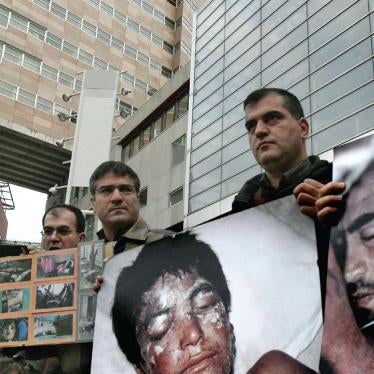NATO forces have done far too little to arrest the indicted architects of the 1995 Srebrenica massacre, Human Rights Watch charged in a new briefing paper released on the eve of Srebrenica’s tenth anniversary. The authorities in Bosnia and Serbia are also to blame for the failure to bring to justice the men most wanted for the massacre – the worst atrocity in Europe since World War Two.
As a result, the two most renowned indictees remain at large: Radovan Karadzic, the wartime Bosnian Serb leader, and Gen. Ratko Mladic, wartime commander of the Bosnian Serb forces.
“You can count on one hand the number of times NATO has made real attempts to arrest Karadzic and Mladic,” said Holly Cartner, the Europe and Central Asia director at Human Rights Watch. “The authorities must know where these men are. If they don’t know, they are not looking very hard.”
On July 11, 1995, the United Nations and NATO allowed Bosnian Serb forces to seize Srebrenica, despite it having been declared a United Nations “safe area.” Serb forces killed between 7,000 and 8,000 Bosnian men and boys in the week after the fall of the town. The International Criminal Tribunal for the former Yugoslavia (ICTY) has ruled the crimes in Srebrenica to be genocide. Both Mladic and Karadzic have been indicted for genocide and crimes against humanity for Srebrenica and other wartime abuses in Bosnia.
According to the 25-page briefing paper , NATO peacekeepers in Bosnia have made only three confirmed attempts to arrest Radovan Karadzic in the past decade. Since December 2004, most western troops in Bosnia wear European Union rather than NATO helmets. The EU force (EUFOR) has yet to carry out any arrest attempt.
Until mid-1997, NATO claimed that arresting the former Bosnian Serb leader and other indicted war crime suspects was not in its mandate. NATO has admitted that concerns about possible reprisals against its troops – so-called “force protection” – have hampered its willingness to take action.
NATO has often offered the excuse that Karadzic’s whereabouts are unknown. But sightings of Karadzic have been more numerous than arrest attempts, and successive prosecutors at the ICTY have criticized NATO inaction. During 1996-98 when NATO did direct significant intelligence resources to locating Karadzic, western officials admit that force protection and worries over leaks from within NATO ultimately stymied efforts to arrest him.
“Karadzic’s continuing freedom a decade after Srebrenica is a profound moral failure for NATO and the international community,” said Cartner.
NATO and the authorities in Serbia share responsibility for Ratko Mladic not facing justice. The wartime Bosnian Serb general spent the latter half of the 1990s in Bosnia, before moving to Serbia. NATO made no attempt to arrest Mladic while he was still residing in Bosnia, and only one attempt during his subsequent visits to Bosnia from Serbia. Successive democratic governments in Serbia since the fall of Slobodan Milosevic in October 2000 have also failed to arrest Mladic, who has been protected by elements of Serbia’s military outside the control of the government.
During 2001 and 2002, Serbian officials made contradictory statements about Mladic. Some acknowledged that Mladic was in Serbia, while others denied it. Since 2002, Serbia’s official explanations for the failure to arrest Mladic are that he is not in Serbia or his whereabouts are unknown. Reported sightings of Mladic in recent years, coupled with claims by the ICTY prosecutor that Mladic is in Serbia, call into question the credibility of the government’s denials.
“Serbia's failure to arrest Mladic is a stain on its reputation.” said Cartner. “It’s time for Belgrade to send him to The Hague.”
A change in public opinion in Serbia might make the task of arresting Mladic easier, Human Rights Watch said. Recently, the Serbian public has reacted in shock to a July 1995 video clip showing Serbian troops executing four boys and two men from Srebrenica. On June 2 and June 10, Serbian police arrested five individuals allegedly involved in the killing. The government of Serbia should use this momentum to arrest Mladic, Human Rights Watch said.
Missed Opportunities and Failed Attempts
Radovan Karadzic
Sightings:
- September 2, 2000 - Karadzic was present at a small bar in Lukavica, the Serb-controlled suburb of Sarajevo, according to a Bosnian newspaper.
- May 2002 - Karadzic was hiding in the Banja Luka region, in northwestern Bosnia, according to ICTY Chief Prosecutor Carla Del Ponte.
- April 7, 2005 - Karadzic had lunch with his wife in a restaurant on the Foca-Gacko roadway, in southeastern Republika Srpska, apparently in readiness for the death of his mother and to prepare for her funeral, according to the Bosnian police.
Arrest attempts:
- February 28/March 1, 2002: Large numbers of U.S., French, German and Italian forces entered the village of Celebici in mountainous southeastern Bosnia, searched buildings in the village and sealed off roads. Karadzic was not found.
- January 11-13, 2004: U.S., British and Italian troops raided the house of Radovan Karadzic and several other buildings in Pale, near Sarajevo. Karadzic was not found.
- April 1, 2004: British NATO troops, backed by local police, sealed off the area surrounding the Parochial Home in the center of Pale and used explosives to break into the building. Karadzic was not found.
Ratko Mladic
Sightings:
- On October 21, 2002, Mladic dined with friends at a restaurant in the Topcider district of Belgrade, as the ICTY Prosecutor was meeting foreign diplomats in a nearby building.
- In January 2003, according to the ICTY prosecutor, Mladic received medical assistance in a military hospital in Belgrade, and visited another man indicted by the ICTY in the same hospital.
- In June 2004, Mladic was seen at a military compound in the Topcider district, according to a former sergeant interviewed by a Belgrade newspaper. The interview detailed the army’s involvement in protecting Mladic in 2004.
Arrest attempts:
- On July 2, 2004, NATO troops raided a military bunker in Han Pijesak, Bosnia, after receiving information that Mladic was visiting the base. Mladic was not found.






